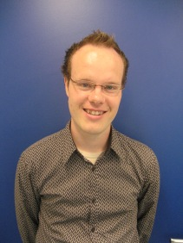Field emission sensing for non-contact probe recording
Promotion date: 28. March 2008
Thesis advisor: Prof. dr. Cock Lodder
Assistant thesis advisor: Dr. ir. Leon Abelmann
| In the micro scanning probe array memory concept, an array of magnetic probes is used to write and read on a patterned recording medium. There is a need to position individual probes at several nanometers above the recording medium, to be able to detect the small magnetic forces. Current research still lacks a proximity sensor that can be integrated in each probe. In my thesis I show that field-emission can be used as an integrated method to control the probe-medium distance. This can be applied for non-contact probe recording with a lateral resolution, on the same order as the targeted bit size, of about 10 nanometers. |
What kind of approach did you follow in this thesis project?
I carefully studied the technology of using an array of probes - in the future up to ten thousand of it - for reading and writing on a medium, without having contact. To achieve this, a combination of Atomic Force Microscopy (AFM) and Scanning Tunneling Microscopy (STM) is used.
AFM usually measures while making contact, while STM is a non-contact method that uses relatively short distances (one nanometer), low voltage (1 V) and low currents (1 nano-ampère).
In our approach we used higher voltages than normal in STM because, in the process of writing and reading, the probe must move from very close to some more distance from the medium, to be able to get information from it. It is shown, at last, that this can indeed be used to control the operating distances, from approximately one to a hundred nanometers.
So ... it wasn't an easy job ...
We did come across some serious experimental difficulties. Reality showed more unruly than was expected. In short, field-emission is known to be a rather unstable process. Therefore reproduction of the results is a difficult job. We did the measurements under severe vacuum conditions, which was really necessary to improve the stability.
Another matter of concern was the bending behaviour of the cantilevers of the AFM probes that are used in probe recording. We used stiff cantilevers to prevent the probes electrostatically snapping into the surface before field emission starts.
How were you able to solve these rather fundamental problems?
First of all, I met Chung-Kai Yang, from the institute DIMES in Delft. I read about his work in a paper and found out that we had similar goals. He made, especially for me, a lot of very usuable probes, with AFM-like tips without cantilever, to be able to test the field emission properties, without the bending effect.
Also I collaborated with the group of Tjerk Oosterkamp, from the University of Leiden. They are able to bond carbon nanotubes by an electron bundle, to the measuring tip of the AFM probe. These nanotubes are well-known, for the good field emission properties. They may allow us to improve the stability and lower the vacuum requirements.
So you had some struggles?
Yes, that's fair to say. It took more than two years before I could start making useful observations, because I first had to build and test the measurement setup. I was lucky enough to get an extension period in the project, to be able to reach my goals.
And more than that, the group always supported me, and trusted my way of working. That was very important. I am glad I could show a proof-of-principle to them, of the way measurements and control can be carried out in this specific way. Although more research is necessary to come to real applications, the first steps are taken and the equipment is ready.
What are your future plans?
I would like to work in a more commercial context, for example in the vicinity of Eindhoven. Big companies like Philips, TNO, ASML and FEI are situated there. More or less, I imagine that such an environment is more suitable for me. The advantage of academic research is that it is relatively free and a lot of real smart people are involved in it. On the other hand, I feel that I prefer a more strict plan of investigation. Not every problem is worthwhile of investigating in depth.
You assume that will be different, when working in a company?
Yes, I think so. Of course, sometimes it can be hard to leave an interesting path of investigation. But to change direction is also very refreshing and gives way to new possibilities. You should not be afraid of that.
In the future, after some years of experience, I aim to play a role in these kind of processes. I have a passion for technology, but I would like to talk and listen to commercial people also. Explaining to them what research is capable of and, vice versa, explaining to researchers about the wishes of the commercial market, might be very interesting.
Are these kind of processes important for Mesa+ as well, in the future?
Yes, I guess so. Sometimes research groups are defensive, protecting their own fields of interest. That can be disadvantageous for the content of research at Mesa+. A strong point within Mesa+ is the multidisciplinary approach, so maybe groups should try to formulate more proposals together. Perhaps for PhD's an idea is to switch during the project, from one group to another?
Also colloquia should be visited more regularly. These colloquia can inform researchers from different backgrounds about each others work. That way of informing and enriching your capabilities, as a whole, fits in very well in a knowledge institute, based at a university.

